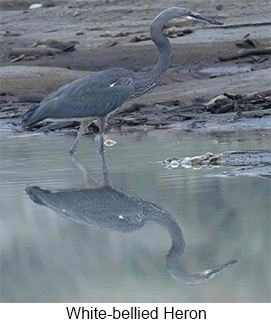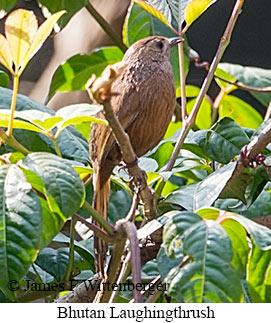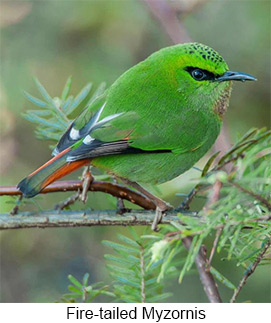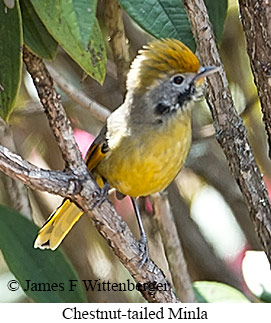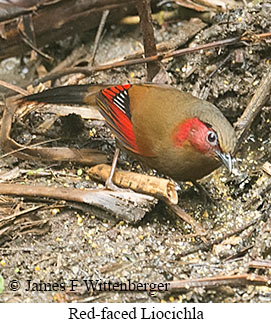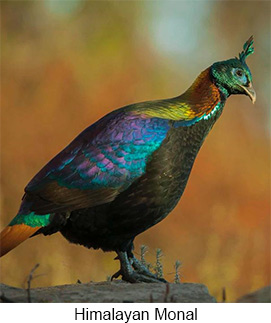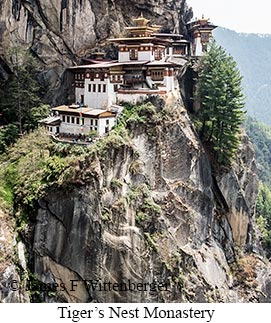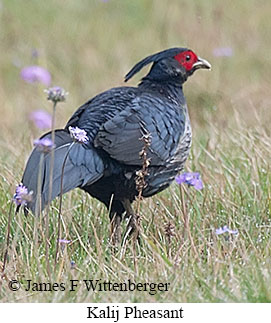BHUTAN STANDARD BIRDING TOUR
Tour Description

BHUTAN
BIRDING TOUR
ANY TIME*
| Duration: | 16 days, 15 nights |
| Group Size: | 2-6 |
| Anytime Price: | $6900 |
| Group Price: | $6250 |
| Single Suppl: | $500 |
| Est #Species: | 275-325 |
| Pace: | Easy to Moderate |
| Difficulty: | Moderate |
| * This tour is available for any dates of your choosing provided guide services and accommodations are available. | |
DAY 1 - ARRIVAL , PARO, & THIMPHU
The tour begins in Paro, the main gateway to Bhutan and currently the only international airport. Paro is reached by flights from Delhi, India or from Bangkok, Thailand. Flights from Delhi may arrive in the evening, in which case it's necessary to arrive the night before the tour begins. Flights from Bangkok alternate between morning and afternoon arrival. We strongly recommend traveling through Bangkok and timing the tour to arrive in Paro in the morning. Following arrival, we'll check the river near the airport for the rare, uniquely beautiful Ibisbill that regularly occurs there. From there we transfer to Thimphu, about an hour's drive. AFternoon we'll visit the fascinating School of Arts and Crafts in Thimphu. Night at a hotel in Thimphu.
DAY 2 - JIGME DORJI NATIONAL PARK & THIMPHU
We'll depart early for the drive to Jigme Dorji National Park in the Tashitang Valley. It's about a 45min. drive up the Cheri Valley to the entrance area. Much of this very large park is inaccessible. It's the only park in the world where Snow Leopards and Tigers coexist. We won't be seeing either one there. We do expect some good birding along from roadsides. This site is our first chance to see the striking Satyr Tragopan. We can also expect to see birds such as Mountain Hawk-Eagle, Darjeeling Woodpecker, Yellow-billed Blue-Magpie, Green-backed Tit, Lemon-rumped Warbler, Yellow-bellied Warbler, White-browed Fulvetta, Rufous-vented Yuhina, Black-faced Laughingthrush, Chestnut-crowned Laughingthrugh, Rufous Sibia, Hoary-throated Barwing, Spotted Laughingthrush, Gray-winged Blackbird, Mrs. Gould's Sunbird, and Red-headed Bullfinch. With some luck we could also see the secretive Hill Partridge. After lunch back in Thimphu, we'll spend the afternoon visiting the Postal Museum, Textile Museum, and the massive Buddha Dordenma monument. Night at a hotel in Thimphu.
DAY 3 - DOCHU LA PASS & PUNAKHA
This morning we'll drive through the scenic Dochu La Pass, reaching 10,100ft in elevation, birding en route.The pass is noteworthy for the memorial and 108 small stupas commemorating a military victory over rebels from Assam in 2003. Our primary target bird in the pass is Great Parrotbill. A second target bird is the lovely Fire-tailed Myzornis. encounter other birds that occasionally show themselves such as the skulking Hill Partridge, as well as Gray-backed Shrike, Large-billed Crow, Scaly-breasted Munia, Alpine Accentor, Common Rosefinch, and Dark-rumped Rosefinch. From the pass we'll descend toward Punakha, stopping at several more birding sites. First of these is the Lampeli Botanical Gardens where we may see Besra, Rufous-bellied Woodpecker, Ashy Drongo, Eurasian Jay, Gray-headed Canary-Flycatcher, Chestnut-crowned Warbler, Chestnut-crowned Laughingthrush, Hodgson's Treecreeper, White-browed Bush-Robin, and Rufous-breasted Accentor. We'll stop for lunch farther down the pass. Some birding near the restaurant may yield Black-faced Warbler, Verditer Flycatcher, and Green-tailed Sunbird. After arrival in Punakha, we'll visit the majestic Punakha Dzong. Some of the walls inside are lined with many small Buddha statues donated by families to bring good fortune. Other walls are covered by extraordinary murals depicting the life and myths of the oridinal Buddha. Several large statues in the back are of Buddha and the current king. Night at a hotel in Punakha.
DAY 4 - TSIRANG AREA
Transfer to Damphu Tsirang District, birding en route and later stopping to visit the White-bellied Heron breeding center. This district has only recently been opened to tourism and is the place where north meets south in Bhutan. The culture around Tsirang is a mix of two ethnic groups, the Drukpa from the north and Nepalese from the south. The habitat in this area is mainly chir pine and deciduous forest. Our major target species is the White-bellied Heron along the river. Only about 27 individuals of this critically endangered species remain in Bhutan and only about 60 worldwide. We'll spend some time on an overlook high above the rover at a known site where a pair nests in hopes of seeing this rarity. Before we reach that site, we'll bird through the Punakha Valley along the river where we can expect Ruddy Shelduck, Pied Avocet, River Lapwing, Great Cormorant, Crested Kingfisher, and Eurasian Hoopoe. Farther south we can expect White-throated Kingfisher, Chestnut-headed Bee-eater, Blue-throated Barbet, Short-billed Minivet, Bar-winged Flycatcher-Shrike, Gray Treepie, Black-throated Prinia, Black Bulbul, Gray-hooded Warbler, Indian White-eye, Spot-winged Starling, Orange-headed Thrush, Crimson Sunbird, and Crested Bunting. Night at a hotel in Damphu.
DAY 5 - DAMPHU HIGHLANDS & TRONGSA
We'll being the day birding the highlands above Damphu. These forests are home to hornbills such as Great Hornbill, Oriental Pied-Hornbill, Rufous-necked Hornbill, and Wreathed Hornbill. Other birds in the highlands include Black Eagle, Striated Bulbul, Black-throated Tit, Gray-crowned Tit, Whiskered Yuhina, Striated Laughingthrush, Bhutan Laughingthrush, Blue-winged Minla, Red-billed Leiothrix, Silver-eared Mesia, White-crested Laughingthrush, Pale Blue Flycatcher, White-capped Redstart, and Gray-headed Warbler. Mid-day we'll being the 5 hour transfer to Trongsa, retracing our route back north toward Wangdue Phodrang and then eastward. Night at a hotel near Trongsa.
DAY 6 - MANGDE CHHU RIVER & TINGTIBI
Depart early for a birding excursion south to Tingtibi, following the Mangde Chhu part of the way. We'll be birding en route and in the forests around Tingtibi. This town is located in the very northern corner of the huge Royal Manas National Park. We'll spend the afternoon and next morning birding around Tingtibi. Of particular interest are stands of bamboo, home to bamboo specialists such as Pale-headed Woodpecker, Yellow-bellied Warbler, Pale-billed Parrotbill, Black-crowned Scimitar-Babbler, and White-hooded Babbler. Many other birds occur in this amazing place. Notable species include Pin-tailed Green-Pigeon, Himalayan Cuckoo, Collared Owlet, Chestnut-headed Bee-eater, Gray-chinned Minivet, White-bellied Erpornis, Bronzed Drongo, Ashy Bulbul, Green-crowned Warbler, Black-throated Tit, Gray-crowned Tit, Black-chinned Yuhina, Nepal Fulvetta, Rufous-necked Laughingthrush, Orange-headed Thrush, Small Niltava, Pale Blue Flycatcher, Blue-throated Flycatcher, Fire-breasted Flowerpecker, Red-headed Bullfinch, and Gray-headed Bullfinch. We also have an excellent change to see the near endemic Golden Langur. Night at a hotel in Tingtibi.
DAY 7 - TINGTIBI & BUMTHANG
We'll spend the morning birding around Tingtibi and then transfer back north to Bumthang, which is located farther east and north of Trongsa. En route we'll stop at the Tharpaling Monastery where the monks feed the birds. We should have excellent views of Himalayan Monal, a normally quite shy bird that we may also see along the road en route. We also hope to see Snow Pigeon and Altai Accentor there. Some optional night birding will give us a chance to see the uncommon Himalayan Owl. Night at a guesthouse in Bumthang.
DAY 8 - SENGOR & NAMLING
This day we'll drive eastward toward the highlands above Yongko La town, which offers some of the best birding in the world. Along the way we should have another view of Himalayan Monal. Around Sengor we can expect species such as Red-billed Chough, Rufous-vented Tit, Gray-crested Tit, Buff-barred Warbler, Fire-tailed Myzornis, White-browed Fulvetta, White-collared Blackbird, Golden Bush-Robin, Fire-tailed Sunbird, and Alpine Accentor. As we descend from there we should have very good views of two specials, Blood Pheasant and Satyr Tragopan along the road. Farther along we can expect species such as Golden-throated Barbet, Yellow-rumped Honeyguide, Black-headed Shrike-Babbler, Green Shrike-Babbler, Yellow-billed Blue-Magpie, Bar-winged Wren-Babbler, Slender-billed Scimitar-Babbler, Chestnut-tailed Minla, and Mrs. Gould's Sunbird. Night at Trogon Villa Lodge.
DAYS 9-10 - HIGHLANDS ABOVE YONGKO LA
We'll spend two full days birding around Yongko La. The exact locales depend on our birding success each day. Birding in this area is considered some of the best in the world. For the most part we'll bird an altitudinal transect going up the mountain toward Yongko La pass, but we will spend one morning lower down near the hotel and below where different species occur. Every day will bring new species and new surprises. We'll encounter plenty of mixed flocks centered around yuhinas. Some of the common birds we can expect include Rufous-necked Hornbill, Great Barbet, Golden-throated Barbet, Gray-chinned Minivet, Long-tailed Minivet, Gray Treepie, Green-backed Tit, Yellow-cheeked Tit, Yellow-browed Tit, Nepal House-Martin, Black Bulbul, Ashy-throated Warbler, Lemon-rumped Warbler, Gray-cheeked Warbler, Blyth's Leaf Warbler, Black-faced Warbler, Black-throated Tit, Gray-crowned Tit, Whiskered Yuhina, Rufous-vented Yuhina, Black-chinned Yuhina, Rufous-capped Babbler, Yellow-throated Fulvetta, Striated Laughingthrush, Himalayan Cutia, Rufous Sibia, Hoary-throated Barwing, Blue-winged Minla, Rusty-fronted Barwing, Chestnut-tailed Minla, White-throated Laughingthrush, Rufous-crowned Laughingthrush, Chestnut-bellied Rock-Thrush, Blue-capped Rock-Thrush, Gray Bushchat, Fire-breasted Flowerpecker, Mrs. Gould's Sunbird, and Green-tailed Sunbird. Less common or more secretive are White-throated Fantail, Sultan Tit, Chestnut-headed Tesia, Aberrant Bush Warbler, Golden-breasted Fulvetta, White-browed Fulvetta, Black-throated Parrotbill, Little Forktail, White-naped Yuhina, Golden Babbler, Black-crowned Scimitar-Babbler, Slender-billed Scimitar-Babbler, Streak-breasted Scimitar-Babbler, Rusty-cheeked Scimitar-Babbler, Rufous-winged Fulvetta, and Scarlet Finch. Closer to our hotel are several specialties, some coming to a farmhouse where the owner puts out seed for them, some scarce and only found nearby. These include Tawny Fish-Owl, Himalayan Bulbul, Blue-winged Laughingthrush, Red-faced Liocichla, Scarlet-faced Liocichla, and Rufous-necked Laughingthrush. We'll also do some optional night birding looking for Hodgson's Frogmouth, Gray Nightjar, Mountain Scops-Owl, Brown Wood-Owl, and Himalayan Owl. Nights at Trogon Villa Lodge.
DAY 11 - SENGOR &l CHUMEY
This day we'll retrace our route back toward Chumey following the same highland road we birded previously. If we saw most of our target species coming to Yongko La, we'll spend much of the day birding the highlands below Yongko La looking for species not yet seen the previous two days. We'll then transfer back over Yotong La to Chumey for an overnight stay there.ıBLDıNight at a hotel in Chumey.
DAY 12 - TRONGSA & PHOBJIKHA VALLEY
We'll depart early this day for the scenic town of Trongsa, birding en route. We have a good chance of seeing Himalayan Monal once again. Other possibilities include Darjeeling Woodpecker, Eurasian Nutcracker, Coal Tit, Rufous-vented Tit, Buff-barred Warbler, Lemon-rumped Warbler, Gray-sided Bush Warbler, Streak-breasted Scimitar-Babbler, Black-faced Laughingthrush, Red-tailed Minla, Rufous-breasted Accentor, and Dark-rumped Rosefinch. We also have a chance for the rare Black-headed Shrike-Babbler. From Trongsa we'll continue on to the Phobjikha Valley. The only new species we can expect there are Himalayan Griffon and Oriental Skylark. The Phobjikha Valley is most notable as the main wintering ground of the Black-necked Crane. This species will have already migrated north by April, but the visitor center devoted to its conservation is worth visiting. Night at a hotel in the Phobjikha Valley.
DAY 13 - PELE LA PASS & TRANSFER
Depart early for Pele La Pass for some high altitude birding around 11,220ft. The pass is quite scenic with a large stupa with prayer flags marking the site, and colorful native Rhododendrons should be in full bloom. This area is a good place to pick up Himalayan Monal if not seen earlier. Other birds we hope to see include Speckled Wood-Pigeon, Himalayan Buzzard, Rufous-bellied Woodpecker, Eurasian Jay, Eurasian Nutcracker, Yellow-bellied Fairy-Fantail, Whistler's Warbler, Brownish-flanked Bush Warbler, Rufous-breasted Accentor, Rosy Pipit, White-winged Grosbeak, Himalayan White-browed Rosefinch, Crimson-browed Finch, and Red-headed Bullfinc. After birding and breakfast in the field, we'll drive westward toward Paro. Downslope from the pass we'll stop where we have another chance to see Ward's Trogon. We hope to see this tricky species in the highlands above Yongko La, but this site is a second chance if we missed it earlier. From there we'll drive downslope toward the Punakha Valley, then up Dochu La retraciing our route back to Paro. We should arrive in Paro by late afternoon. Night at a hotel in Paro.
DAY 14 - TIGER'S NEST MONASTERY & PARO
No visit to Bhutan is complete without a visit to the famed Tiger's Nest Monastery, which is perched high on the side of a cliff outside Paro. The original monastery was built in the 8th century, but the complex of buildings was later built in 1692. In April 1998 a fire broke out in the main building, causing significant damage. The monastery was later restored in 2005 at considerable cost. The hike up to the monastery is moderately strenous, involving 900m (3000 ft.) of elevation gain. The trail up consists primarly of wide steps carved out of the mountainside. It's possible to get decent views half way up the trail, where a restaurant is located. Still higher up is a lookout. From there the monastery is reached by climbing down about 500 steps into a gorge and then back up 200 steps on the other side. The monastery is perched on a ledge above a vertical cliff. This day of the tour will be devoted to hiking up to the monastery, which can take anywhere from a few hours to much of the day depending on a person's fitness. Many visitors are usually doing the hike, some of whom are going to the monastery for religious purposes or in hopes of being cured of ailments. Later in the afternoon, after the hike, we'll visit the Drukgyal Dzong outside Paro. This dzong was built as a fortress but the interior is now in ruins.
DAY 15 - CHELE LA & PARO
Morning birding the highlands of Chele La, the highest point on the road between Paro and the Ha Valley. This is an excellent site to see the iridescent Himalayan Monal if it was missed earlier. Also present there are Blood Pheasant and Kalij Pheasant. The alpine meadows at the pass and forest a bit lower down offer Eurasian Nutcracker, Red-billed Chough, Whistler's Warbler, Bhutan Laughingthrush, Chestnut-crowned Laughingthrush, Spotted Laughingthrush, White-throated Laughingthrush, Rufous-crowned Laughingthrush, White-winged Grosbeak, and Himalayan White-browed Rosefinch. In the afternoon, we'll visit some wetlands around Paro where our primary target bird is the secretive Black-tailed Crake. In addition, we hope to pick up Eurasian Woodcock. With some luck we could also find Himalayan Bluetail.
DAY 16 - END OF TOUR
After breakfast transfer to the airport for international flight home. Tour ends at the airport.
TOUR NOTES
Tour price is based on number of nights. The posted price assumes arrival on Day 1 of the tour and transferring directly to Thimphu.
ADDITIONAL INFO
(Not on Menu Above)
BIRDING LOCALES
